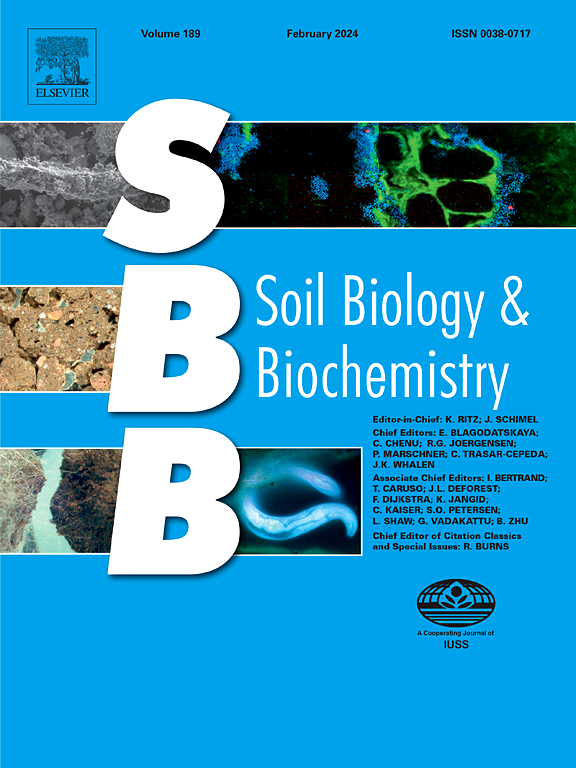Impact of different soil erosion levels on gross N transformation processes and gaseous N losses: An incubation study
IF 10.3
1区 农林科学
Q1 SOIL SCIENCE
引用次数: 0
Abstract
Erosion is a key driver of topsoil removal in agriculture, resulting in nutrient losses and leaving truncated soil profiles on shoulder slopes, where subsoil material can be incorporated into topsoil by the plough, changing soil properties and, thus, altering biogeochemical cycling and associated nitrogen (N) losses. To date, the effects of topsoil erosion on N cycling have rarely been investigated. We conducted a short-term mesocosm experiment, integrating 15N tracing techniques to quantify N transformation processes, focusing on N availability and N losses in three artificially eroded agricultural topsoils. Nitrogen transformation pathways were simulated using the numerical model Ntrace, considering N uptake by maize (Zea mays L.) at early development stages. The 15N label also allows the quantification of nitrous oxide (N2O) and dinitrogen (N2) losses by applying the 15N gas flux method (15NGF).
Erosion induced topsoil dilution significantly reduced gross N turnover and consequently N2O and N2 emissions in both treatments with and without plants. The oxidation of ammonium (NH4+) to nitrate (NO3−) was by far the dominating N pathway across all investigated topsoils, followed by Norg mineralization > NH4+ immobilization. However, more than 90 % of total N2O losses derived from the NO3− pool, with coupled nitrification-denitrification assumed to be the dominant process at water contents of ∼40 % water-filled pore space (WFPS). Although maize more than doubled N2O + N2 emissions in some treatments, the overall effect of topsoil dilution on gaseous N losses was considerably greater, independent of maize presence. Our study contributes to a more comprehensive understanding of N cycling in erosion-affected agricultural soils, which is essential for enhancing N fertilizer use efficiencies and reducing N pollution.


不同土壤侵蚀水平对总氮转化过程和气态氮损失的影响:一个孵化研究
侵蚀是农业中表层土壤流失的一个关键驱动因素,导致养分流失,并在肩坡上留下截短的土壤剖面,在那里,底土物质可以通过犁被纳入表层土壤,改变土壤性质,从而改变生物地球化学循环和相关的氮(N)损失。迄今为止,对表层土壤侵蚀对氮素循环的影响研究甚少。通过短期中观试验,采用15N示踪技术定量分析了3种人工侵蚀农业表层土壤的N有效性和N损失。考虑玉米(Zea mays L.)发育早期对氮的吸收,利用数值模型Ntrace模拟了氮素转化途径。15N标签还允许通过应用15N气体通量法(15NGF)来量化一氧化二氮(N2O)和二氮(N2)损失。在有植物和不带植物的处理中,表土侵蚀显著减少了总氮周转量,从而减少了N2O和N2的排放。铵态氮(NH4+)氧化成硝态氮(NO3-)是表层土壤中主要的氮途径,其次是硝态氮矿化;NH4 +固定。然而,超过90%的N2O总损失来自NO3-池,在水含量为~ 40% WFPS时,耦合硝化-反硝化被认为是主要过程。尽管在某些处理中,玉米的N2O+N2排放量增加了一倍以上,但表土稀释对气态氮损失的总体影响要大得多,与玉米的存在无关。本研究有助于更全面地了解受侵蚀农业土壤的氮循环,对提高氮肥利用效率和减少氮污染具有重要意义。
本文章由计算机程序翻译,如有差异,请以英文原文为准。
求助全文
约1分钟内获得全文
求助全文
来源期刊

Soil Biology & Biochemistry
农林科学-土壤科学
CiteScore
16.90
自引率
9.30%
发文量
312
审稿时长
49 days
期刊介绍:
Soil Biology & Biochemistry publishes original research articles of international significance focusing on biological processes in soil and their applications to soil and environmental quality. Major topics include the ecology and biochemical processes of soil organisms, their effects on the environment, and interactions with plants. The journal also welcomes state-of-the-art reviews and discussions on contemporary research in soil biology and biochemistry.
 求助内容:
求助内容: 应助结果提醒方式:
应助结果提醒方式:


